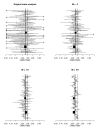Undue reliance on I(2) in assessing heterogeneity may mislead
- PMID: 19036172
- PMCID: PMC2648991
- DOI: 10.1186/1471-2288-8-79
Undue reliance on I(2) in assessing heterogeneity may mislead
Abstract
Background: The heterogeneity statistic I(2), interpreted as the percentage of variability due to heterogeneity between studies rather than sampling error, depends on precision, that is, the size of the studies included.
Methods: Based on a real meta-analysis, we simulate artificially 'inflating' the sample size under the random effects model. For a given inflation factor M = 1, 2, 3,... and for each trial i, we create a M-inflated trial by drawing a treatment effect estimate from the random effects model, using s(i)(2)/M as within-trial sampling variance.
Results: As precision increases, while estimates of the heterogeneity variance tau(2) remain unchanged on average, estimates of I(2) increase rapidly to nearly 100%. A similar phenomenon is apparent in a sample of 157 meta-analyses.
Conclusion: When deciding whether or not to pool treatment estimates in a meta-analysis, the yard-stick should be the clinical relevance of any heterogeneity present. tau(2), rather than I(2), is the appropriate measure for this purpose.
Figures




References
-
- Sidik K, Jonkman JN. Simple heterogeneity variance estimation for meta-analysis. JRSS Series C (Applied Statistics) 2005;54:367–384. doi: 10.1111/j.1467-9876.2005.00489.x. - DOI
Publication types
MeSH terms
LinkOut - more resources
Full Text Sources
Research Materials

